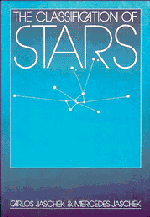5 - Photometric systems
Published online by Cambridge University Press: 04 April 2011
Summary
In this chapter we shall study two photometric systems in order to show in detail some of the uses of a photometric system. We have chosen the UBV and the uvby or Strömgren system. For other photometric systems the reader is advised to consult Golay (1974) or Straizys (1977).
The UBV system
The UBV system was developed in the fifties by Johnson (see Johnson and Morgan 1953) for the photometric study of stars classified in the Yerkes system.
It uses three wide passbands, each about a thousand angstroms wide, called U (ultraviolet), B (blue), and V (visual), with λ0 around λ3500, λ4300 and λ5500 respectively. The choice of the passbands was made in part for historical reasons. V corresponds approximately to the ‘visual magnitudes’ handed down essentially from Ptolemy. B corresponds on the average to the ‘photographic magnitudes’ of the end of the nineteenth century. Finally U was chosen so as to get as much ultraviolet light as possible. The functions S(λ) are tabulated in table 5.1, but readers should be warned that different authors use slightly different S(λ). The system is thus not suited for very high precision. Furthermore the S(λ) of the U color goes down to λ3000, whereas the atmosphere usually cuts off the spectrum below λ3300. The ultraviolet limit of the U band is therefore not fixed by the filter system, but differs from place to place (for instance with the elevation of the observatory) and sometimes from night to night.
- Type
- Chapter
- Information
- The Classification of Stars , pp. 73 - 92Publisher: Cambridge University PressPrint publication year: 1987

